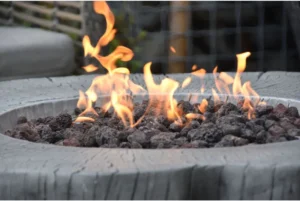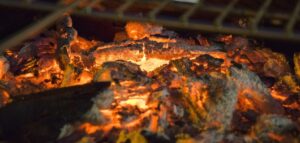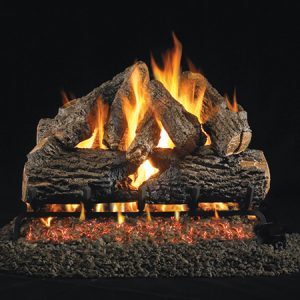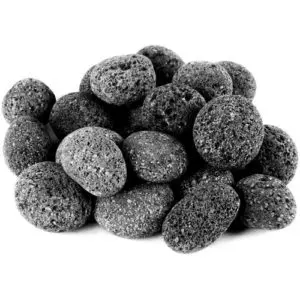If you’re looking to bring some natural beauty and improved heat distribution to your gas fireplace, consider using lava rocks. These porous rocks add a rustic touch to your fireplace while also helping to distribute heat evenly throughout the room, but you need to learn how to place lava rocks in gas fireplace.
To place lava rocks in a gas fireplace, first, prepare the fireplace by cleaning it and disconnecting the gas supply. Choose the right size and type of lava rocks for your gas fireplace and clean and prime the fireplace before installing a gas fireplace burner pan and placing and arranging the lava rocks in it.
Ignite the fireplace and adjust the flame as needed, and regularly clean and replace the lava rocks to ensure proper function and safety. We’ve got all the information you need. Follow our tips and transform your gas fireplace into a warm, inviting, and stylish space to relax.
How to prepare the gas fireplace for lava rock installation

Before you begin installing lava rocks in your gas fireplace, it’s important to make sure that the fireplace is clean and properly prepared. This will help ensure that the installation goes smoothly and that the lava rocks function effectively in your fireplace.
Here are some steps to follow when preparing your gas fireplace for lava rock installation:
1. Remove any debris or dirt from the fireplace. Use a brush or vacuum to clean out any ashes, dust, or other debris from the fireplace.
2. Inspect the gas fireplace for any damage or issues. Look for cracks, holes, or other damage in the fireplace or its components. If you find any problems, it’s important to address them before installing the lava rocks.
3. Check the gas fireplace’s ventilation system. Make sure that the ventilation system is functioning properly and that there is no blockage or damage to the vents.
4. Disconnect the gas supply. Before you begin working on the fireplace, make sure to turn off the gas supply and disconnect it. This will help prevent accidents and ensure your safety while you work on the fireplace.
Tips for choosing the right size and type of lava rocks for your gas fireplace
There are several factors to consider when choosing the right size and type of lava rocks for your gas fireplace. Here are some tips to help you select the best lava rocks for your needs:
1. Measure the size of your gas fireplace’s burner pan. Lava rocks should be placed in the burner pan of your gas fireplace, so it’s important to measure the size of this pan to ensure you choose the right amount and size of lava rocks.
2. Consider the type of gas fireplace you have. Different types of gas fireplaces, such as vented or unvented, may require different types of lava rocks. Make sure to choose lava rocks that are appropriate for your specific type of gas fireplace.
3. Think about the look you want to achieve. Lava rocks come in a variety of sizes, shapes, and colors, so you can choose the ones that best fit the aesthetic you want to create in your fireplace.
How to properly clean and prime the gas fireplace before adding lava rocks
Before you add lava rocks to your gas fireplace, it’s important to clean and prime the fireplace to ensure that the lava rocks function effectively and look their best. Here’s how to do it:
1. Clean the gas fireplace
Use a brush or vacuum to remove any dirt, dust, or debris from the fireplace. If there are any stubborn stains or buildups, you may need to use a mild cleaning solution to help remove them. Just be sure to use a cleaning solution that is safe for use on gas fireplaces.
2. Prime the gas fireplace
After cleaning the fireplace, it’s a good idea to prime it before adding the lava rocks. This will help the lava rocks adhere to the fireplace and improve their performance. To prime the fireplace, simply apply a thin layer of the manufacturer’s recommended primer to the surface of the burner pan.
The importance of using a gas fireplace burner pan and how to install it
A gas fireplace burner pan is a metal tray that sits underneath the burner and helps to distribute the flame evenly across the fireplace. It’s an important component of a gas fireplace and can help improve the performance and safety of the fireplace.
Here’s how to install a gas fireplace burner pan:
1. Measure the size of your gas fireplace’s burner. Make sure to measure the width, length, and depth of the burner so that you can choose the right size burner pan.
2. Choose a burner pan that fits your gas fireplace. There are a variety of burner pans available, so be sure to select one that is the right size and shape for your gas fireplace. You may also want to consider the material of the burner pan, as some materials may be more durable or heat-resistant than others.
3. Install the burner pan. Follow the manufacturer’s instructions for installing the burner pan in your gas fireplace. This may involve attaching the pan to the fireplace using screws or clips or simply placing the pan in the fireplace.
Steps for safely placing and arranging the lava rocks in the gas fireplace

Once you have prepared your gas fireplace and chosen the right size and type of lava rocks, you can begin placing and arranging the lava rocks in the fireplace.
Here are some steps to follow to ensure that you do it safely and effectively:
1. Wear protective gear. When working with lava rocks, it’s a good idea to wear protective gear such as gloves and safety glasses to protect yourself from sharp edges or debris.
2. Place the lava rocks in the burner pan. Start by placing the lava rocks in the burner pan of your gas fireplace. Arrange the rocks in an even layer, leaving enough space between them to allow for proper airflow.
3. Avoid overfilling the burner pan. It’s important not to overfill the burner pan with lava rocks, as this can block the airflow and cause the fireplace to function poorly. Instead, fill the pan to the recommended level, leaving enough space for the flame to pass through.
4. Add more lava rocks if necessary. If you find that the flame is not reaching all of the lava rocks, you may need to add more rocks to the pan. Just be sure to follow the manufacturer’s recommendations for the number of lava rocks to use in your specific gas fireplace.
How to ignite the gas fireplace and adjust the flame after adding lava rocks
After you have placed and arranged the lava rocks in your gas fireplace, you’ll need to ignite the fireplace and adjust the flame as needed. Here’s how to do it:
1. Turn on the gas supply. Before you can ignite the fireplace, you’ll need to turn on the gas supply and make sure that it is flowing properly.
2. Ignite the fireplace. Follow the manufacturer’s instructions for igniting your gas fireplace. This may involve pressing a button or turning a switch to start the ignition process.
3. Adjust the flame. After the fireplace has ignited, you may need to adjust the flame to ensure that it is burning properly. Use the controls on the fireplace to raise or lower the flame as needed.
Maintenance and care for lava rocks in a gas fireplace
Lava rocks in a gas fireplace require some maintenance and care to ensure that they function effectively and look their best. Here are some tips for maintaining and caring for lava rocks in your gas fireplace:
1. Clean the lava rocks regularly
Over time, lava rocks can become dirty or covered in soot. To keep them looking their best, you’ll need to clean them regularly. Use a brush or vacuum to remove any dirt or debris from the rocks, and wipe them down with a damp cloth if necessary.
2. Replace the lava rocks as neededL
ava rocks will eventually wear out and need to be replaced. Signs that it’s time to replace your lava rocks include cracks or chips in the rocks or a significant decrease in the fireplace’s performance. When replacing the lava rocks, be sure to follow the manufacturer’s recommendations for the amount and type of rocks to use.
3. Follow the manufacturer’s recommendations for maintenance and care
Each gas fireplace and set of lava rocks is different, so be sure to follow the manufacturer’s recommendations for maintaining and caring for your specific model. This may include specific cleaning techniques, frequency of replacement, or other guidelines.
Benefits of using lava rocks in a gas fireplace

Lava rocks have several benefits when used in a gas fireplace. Here are a few of the main advantages of using lava rocks in your gas fireplace:
1. Improved aesthetics
Lava rocks can add a natural, rustic look to your gas fireplace, giving it a more inviting and cozy appearance. There are a variety of sizes, shapes, and colors of lava rocks available, so you can choose the ones that best fit the look you want to achieve in your fireplace.
2. Better heat distribution
Lava rocks are porous, which means they can absorb and release heat more effectively than other types of fireplace media. This can help distribute heat more evenly throughout the room, making your gas fireplace more efficient and effective at heating your space.
3. Easy maintenance
Lava rocks are relatively easy to maintain, requiring only occasional cleaning and replacement as needed. This makes them a convenient and low-maintenance option for your gas fireplace.
Safety considerations when using lava rocks in a gas fireplace
There are several safety considerations to keep in mind when using lava rocks in a gas fireplace. Here are a few tips to help ensure the safety of your gas fireplace:
1. Ensure proper ventilation
It’s important to make sure that your gas fireplace has proper ventilation to prevent the build-up of carbon monoxide and other harmful gases. Follow the manufacturer’s recommendations for ventilation and make sure that the vents and chimneys are clear and functioning properly.
2. Keep flammable materials away from the fireplace
To prevent accidents, make sure to keep flammable materials such as curtains, furniture, or decorations at least three feet away from the fireplace.
3. Follow the manufacturer’s instructions
Be sure to carefully read and follow the manufacturer’s instructions for your specific gas fireplace and lava rocks. This will help ensure that you use the fireplace and lava rocks safely and correctly.
Alternative options for decorating a gas fireplace
Lava rocks are just one option for decorating a gas fireplace. Here are a few other options to consider:
1. Ceramic logs
Ceramic logs are designed to look like real wood logs, but they are made of a special ceramic material that is resistant to heat and wear. They can add a natural, rustic look to your gas fireplace and are relatively easy to maintain.
2. Fire glass
Fire glass is a type of decorative media that is made of small pieces of colored glass. It can add a modern, stylish look to your gas fireplace and is available in a variety of colors and styles.
3. Other decorative media
There are many other types of decorative media available for gas fireplaces, such as pebbles, stones, or crushed glass. You can choose the one that best fits the look you want to achieve in your fireplace.
Conclusion
The lava rocks are a popular option for decorating a gas fireplace and can add a natural, rustic look to the fireplace, but you need to learn the right way on how to place lava rocks in gas fireplace.
However, it’s important to properly prepare the gas fireplace, choose the right size and type of lava rocks, and follow proper safety guidelines when installing and using the rocks. Regular cleaning and maintenance, as well as occasional replacement, can help ensure that the lava rocks function effectively and safely in your gas fireplace.
There are also several alternative options available for decorating a gas fireplace, such as ceramic logs or fire glass, which may be more suitable for certain styles or preferences. Overall, it’s important to carefully consider your options and follow the manufacturer’s recommendations to ensure the safety and effectiveness of your gas fireplace.

